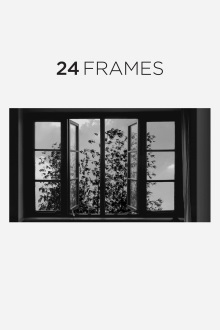
This is considered Abbas Kiarostami’s last film though it was first screened a year after his death and was more generally released only this year. As its title indicates, this is not a movie at all but an experimental film consisting of 24 scenes shot with a completely motionless camera. Humans are almost entirely absent and there is no dialogue. Yet Kiarostami proves that he is still able to tell a story with such minimal materials.
The film opens with text explaining the impetus behind the project. Kiarostami looked at famous paintings and wondered what happened in the few minutes before and after the single frame it represents. So he uses video and special effects to bring Pieter Bruegel’s Hunters in the Snow to life, having birds alight on the branches and a real dog weave around the painted ones. It’s cool and amusing but not really that interesting. However when he moves on to original scenes of his own, the results are nothing short of sublime.
There’s some variety in the shots that are used but most of them are either in black and white or else have very little color in order to be able to capture more detail. Many of the shots also feature falling snow or rain or crashing waves to add dynamism to the stationary camera. With no humans present, animals, most often birds, serve as actors to create a seemingly unplanned narrative. Astonishingly, this is enough to tell a short story in the space of four or five minutes that feels natural with an introduction, a main event and a climax. One early example is a herd of elk that flee when startled by a gunshot. One of them suddenly stops and waits while the rest of the herd passes by and we eventually realize that it is waiting for another animal before moving together. It’s a simple scene but it’s enough to convey that the animals experience emotions and a sense of kinship with one another, and that in turn evokes sympathy in the viewer.
Some sequences seem made just to prove a point, such as demonstrating that it is possible to tell a story about events that take place off-screen using sound or to show how something important that can right in front of you but you won’t see it until your attention is explicitly drawn to it. In all cases, the pure visual beauty of the shots is astounding, being masterpieces of composition and control over light and color. Some sequences make use of music as well and one of my favorite sequences involve a tree swaying in the wind, seemingly dancing to music that is played inside a house. Then there’s how the shots make use of changing light and clouds race across the sky or night gives way to dawn. It is truly humbling to imagine the kind of genius and skill needed to conceive of such a project and the patience to carry it out.
Tyler Cowen wrote on his blog that he thought that 2018 has been the worst year of his adult life for good films. However it seems that he missed watching this. It’s true that I have also found this to be a weak year for films but 24 Frames is far and away the best thing I’ve watched this year and would be a strong film for any year. Kiarostami could not have left a better capstone for his filmography.
One thought on “24 Frames (2017)”